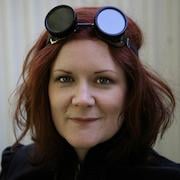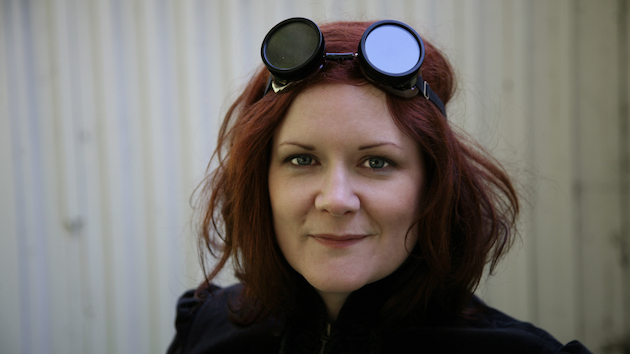
Performing in the intimate Static Illusion Methodical Madness (SIMM) Series last Sunday, at the Musicians Local 6 Union Hall in San Francisco, Lisa Mezzacappa was anything but static. In fact, she was all over her double bass instrument, fingering, plucking, and bowing every part, bending time as well as strings, in the process evoking sequences and sounds unfamiliar even to the experimental jazz fans who flock to this bimonthly event.
And as a composer, curator, and producer, the 42-year-old has shared her far-reaching musical imagination with audiences around the world. Following on a switch from biology to music in undergraduate studies at the University of Virginia, Mezzacappa came west for graduate work in ethnomusicology at UC Berkeley, the leadership of several multigenre ensembles (including the Caribbean folk band Les Gwan Jupons), and a succession of artist residencies.
This month, she’s been engaged by the Exploratorium, at Pier 15 in San Francisco, for their Resonance Series (March 9), which has brought the composer back to an old academic major as well as to much older elements of the evolution of life itself. Across Ninth Street from the Union Hall, before her gig with reed player Matt Renzi and percussionist Jason Levis, we chatted with Mezzacappa over tea at Starbucks.
The press release on your upcoming performance leaves much to the imagination, so I’m glad you’re taking the time to tell us a bit more about it.
Organelle is piece I began working on last Spring, but knew I’d continue over several years, because I wanted it to be modular, I wanted different ensembles to be able to play it with different instrumentation. All of my [previous] bands have been very person-specific.
And you’ve already proven that this new piece travels.
The first version I did in Europe, last spring in Cologne, Rome, and Naples, all different instruments, different personalities, some of them were improvisers, some had rock background, some jazz background, some played experimental music, so they were all coming from different places. Then I did one at the Berkeley Art Museum, last fall, with a sextet of local musicians. Now the Exploratorium has invited me, and I’m so excited. Instead of just showing up the day before, and doing a sound check, I’ve been going there multiple times, driving the staff crazy with my questions and ideas.
Where’s the Exploratorium connection?
My impetus was to connect with some kinds of scientific principles, to have movements based on how science expresses different natural phenomena.
Because there’s science in your background.
I was a biology major in college, in Virginia, before I jumped ship. I was studying plant science and evolutionary biology — and then jazz took over.
How did that evolve?
I just happened to be in this amazing little town in Virginia, Charlottesville, where there were amazing jazz musicians.
So, is Organelle recombining you with biology?
It’s the first time I’ve been able to tap into all that curiosity that made me want to be a biologist.
I’m curious about the piece’s title.
It’s a word from cell biology that describes the small units — organs, basically — that are inside a cell, doing all the different work for the cell. Some of them make energy, some are for excreting, some are for digesting. And, it’s a good-sounding word.
What did you have to do to connect the music with science?
I realized I had to notate things differently. If I wanted this piece to be playable, say, by several percussionists, or several laptop improvisers, or by a guitarist who has weird tuning and can’t read regular notation, I’d have to find a different way to structure these people and bring them into the piece. I’ve brought you a score to look at. This is the next-latest version, which I did in Berkeley, but I knew I wanted to do a new version, so it’ll be a quartet version of some of the existing movements. A percussion quartet will perform most of the concert, but we’ll start the night with a new movement which I’ve been working on with the Exploratorium staff, for solo bass and electronics.
This page of the score looks very trippy.
Each movement is based on something happening in the natural world, whether it’s the natural sciences, the cosmos, or theories of how the Earth and life were created.
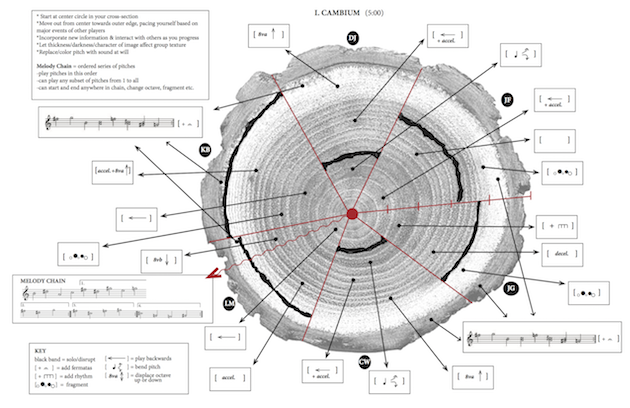
On second glance, this movement looks like a tree section.
It’s fun, because when you look at the cross-section of a tree trunk, it’s a visual way of looking at time passing. When you go up to Muir Woods, there’s a huge cross-section with arrows that point to rings and say “Magna Carta,” or “Abraham Lincoln Assassinated.” As a musician and composer, that’s really interesting to me, because that’s also what we’re engaged with: how do we hear the passing of time together, as musicians? As improvisers? And how do I structure that, as a composer? I didn’t know the score would look this way until I started working on it. I realized I have this real soft spot for how biology and chemistry try to draw diagrams of things that are unfathomable. And something about that connected with trying to draw instructions for musicians.
So all your scoring diagrams are approximations —
— of something unfathomable, way beyond us. And, in a way, music and art are that, too, for me. Music is so much bigger than the dimensions of the score on the page, and the relationships between musicians are so much greater, just the way that understanding the expansion of the universe is so great, or understanding how nerve cells fire.
And each movement has its own title.
This one is called Cambium, which is basically the name for tree rings deposited each year. Each of the musicians will navigate a score that is visually tied to looking at a tree.
What’s the next movement?
This one is called Ephemeroptera, which is the scientific name for the mayfly. The mayfly has the shortest life span on Earth, it lives for one day. So the musicians have a series of one-minute cycles which stand for one day, kind of modeling how we interact, on the life cycle of a mayfly. It’s a really fast interaction, then we’re dead, then we have a new cycle. And we have a few duos, because the mayflies mate in the very short time they’re above water.
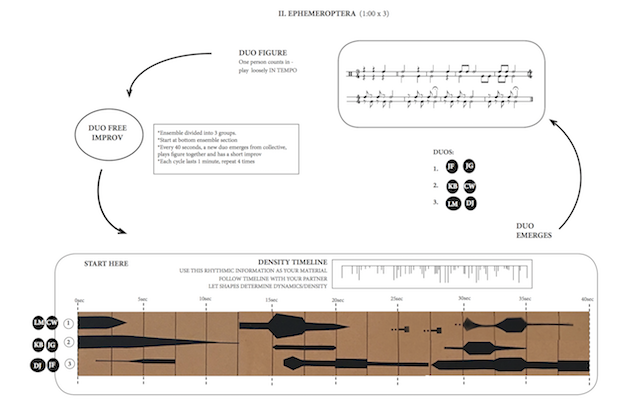
You’ve titled the next movement “Eve.”
Because it’s based on an idea, in evolutionary biology, that every living woman has DNA in her mitochondria, which is one of those organelles in ourselves, and it’s only passed through the female line. So we can actually trace every living woman back to one woman, who the scientists affectionately call “Eve.” We can go backwards and see how the DNA is altered over time.
Your percussionists will all be guys, so they can’t go back in time.
No, it’s only transferred on by females. But I’m having the musicians [in this movement] change their material, over time. And there’s a little place in the DNA where it changes, called the D-loop, so of course I had to have some loops that change over time. We’ll make these little changes and become different, together.
I’m noticing, on the score for Eve, the notation “Coda on cue.” Will you be cueing here?
I’ll actually be conducting the percussion quartet, but not playing, which is a very new thing for me. I’m so used to guiding things from my instrument [bass].
Eve is scored with traditional staves, but they’re arrayed in the form of a rhombus, or diamond. How come?
The musicians have to navigate this traditional notation in a very unusual way: vertically, not horizontally. You have to give really great improvisers a combination of being a little uncomfortable but also a little excited, having fun but not knowing what’s gonna happen. You want to keep them on their toes.
Is it a stretch to suggest that Nature herself improvises?
I guess you could look at all of evolution as a series of improvisations. Some of them stick, and some don’t. [giggles]
Let’s move on to another movement.
The Decay movement is based on how archaeologists and paleontologists date really old things, using Carbon 14, which breaks down at a predictable rate of half-lives.
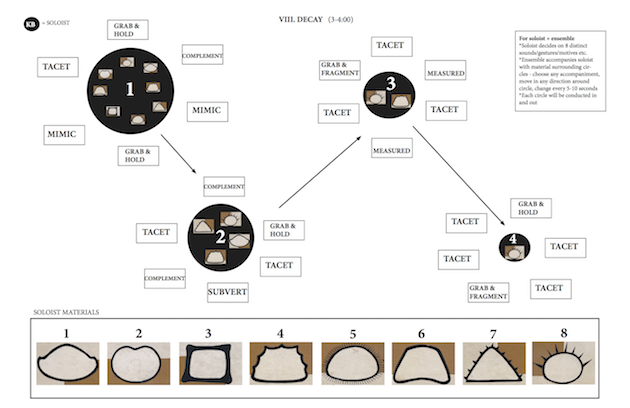
I’m seeing eight weird shapes along the bottom of the score.
Each represents a different sound. This movement will feature Gino Robair, one of our Bay Area treasures as a musical improviser and thinker, as soloist. His job will be to choose these sounds on all the instruments he’s brought, and to decay over time, reducing his material by halves. The others will accompany him: Mark Clifford, Jason Levis, and Kjell Nordeson.
What about that new movement which you said the Exploratorium has a hand in?
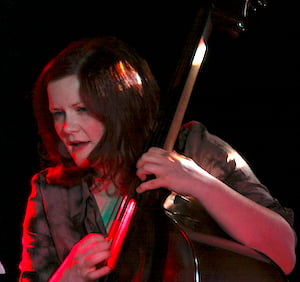
It’s called Szygzy, which is the word in astronomy for when Earth, the moon, and the sun all line up, because this movement is based on tide patterns. The person doing the electronics for this is a staff artist at the Exploratorium, Wayne Grim, and he takes all the data they collect, monitoring eclipses, climate, and the temperature and quality of the Bay, and he writes really sophisticated programs to map the data into sound, so that you can hear it when you walk in. And that’s what I’m gonna interact with: my bass will be accompanied by the tides in the Bay! Which is kind of a beautiful idea. A sound engineer, Andrew Puls, will be following my score to spatialize the sound of my bass and the electronics in the Exploratorium’s Kanbar Forum, with its incredible Meyer Constellation sound system, using hundreds of speakers.
And what will you want folks to exit back out to the Embarcadero with, after the concert?
My curiosity about these things is like anybody else’s. I think people who maybe aren’t into experimental music will understand how we shape things, it’ll make the process more accessible. Maybe people will realize that the value of art is that it’s processing stuff that is already around us, and that this just happens to be happening through music or poetry or painting. That just happens to be how we’re human.

